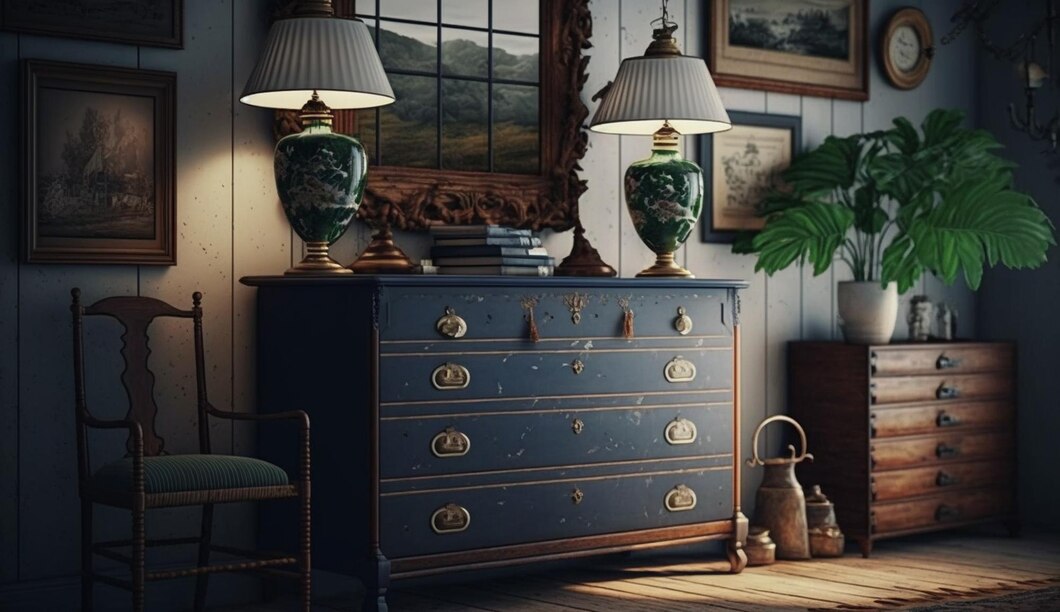From Opulence to Simplicity: A Historical Voyage through Furniture Styles
The world of furniture is not only functional, but it also holds immense significance in our daily lives. From the moment we wake up and sit on our bed to the time we rest on our favourite chair after a long day, furniture remains a constant presence.
However, beyond its practicality, furniture has evolved to become an expression of cultural values and aesthetic sensibilities. In this article, we will embark on a historical journey through various furniture styles, exploring how they have transitioned from purely functional objects to pieces of fashionable art.
Importance of Furniture in Our Daily Lives
Furniture plays a crucial role in enhancing our comfort and well-being. It provides us with essential support, allowing us to relax and rejuvenate. Imagine starting your day without a sturdy bed to sleep in or sitting down for meals without chairs at the dining table—it would be unimaginable!
Moreover, furniture is not merely utilitarian but can also shape our moods and create specific atmospheres within spaces. The right selection of furniture can transform an impersonal room into a warm and inviting sanctuary or convey an air of sophistication.
Evolution of Furniture Styles Over Time
Furniture styles have gone through remarkable transformations throughout history. Each era has introduced unique design elements that reflect the prevailing social, cultural, and artistic movements. From ancient civilizations like Egypt and Greece to medieval times marked by Gothic influences, from opulent Baroque to delicate Rococo styles, each period leaves its distinct imprint on the world of furniture design.

Ancient Furniture Styles
Egyptian furniture: ornate and symbolic designs
In the annals of furniture history, the ancient Egyptians stand out for their opulent and symbolic designs. Egyptian furniture was not merely functional; it was an artistic expression of their deeply entrenched beliefs and societal structure. The furniture of this period was characterized by its intricate carvings, elaborate ornamentation, and attention to detail.
The use of materials such as ebony, ivory, and gold added a touch of grandeur to every piece. Each design element served a purpose, from hieroglyphic motifs that conveyed stories to depictions of gods and goddesses that symbolized protection or invoked blessings.
Use of materials like ebony, ivory, and gold
The choice of materials in Egyptian furniture reflected the wealth and status of its owners. Ebony wood, known for its strength and durability, was often used as a primary material for constructing pieces like chairs, tables, and chests.
Ivory embellishments added luxurious accents to these pieces while also signifying elegance and craftsmanship. Gold leafing or gilding further enhanced the visual appeal by creating a radiant glow that spoke volumes about the owner’s affluence.
Furniture as a reflection of social status and wealth
In ancient Egypt’s hierarchical society, furniture became a powerful indicator of social standing. Possessing lavish furniture showcases one’s prominence within society while also serving practical purposes.
Elaborately carved thrones adorned with symbols denoting power were reserved for pharaohs or high-ranking officials, symbolizing their authority. On the other hand, commoners had more modestly decorated wooden stools or basic mats for seating arrangements.
Greek furniture: simple yet elegant designs
The Greeks introduced a contrasting approach to furniture design with their emphasis on simplicity and refined aesthetics. Inspired by their magnificent architecture, Greek furniture designs aim to create harmonious and balanced living spaces.
The focus was on clean lines, graceful proportions, and an overall sense of balance. Unlike the ornate furniture styles of other ancient civilizations, Greek furniture exuded a sense of understated elegance.
Influence of Greek architecture on furniture styles
The influence of Greek architecture is unmistakable in their furniture designs. Columns with fluted edges translate into chair legs adorned with similar patterns.
The use of marble for tables and benches created a visually pleasing contrast with wooden elements. Greek artisans skillfully incorporated architectural motifs such as acanthus leaves and volutes into their furniture designs, adding an artistic touch that blended seamlessly with the overall aesthetic.
Use of marble, wood, and bronze in construction
Greek craftsmen expertly utilized various materials to construct their iconic furniture pieces. Marble was often employed for tabletops due to its durability and smooth surface, which allowed for easy cleaning.
Wood, particularly oak or walnut, provided the necessary strength for chair frames or cabinet structures while maintaining a natural elegance. Bronze fittings complemented these materials, offering not only functional support but also adding a touch of opulence through decorative accents.
Gothic Furniture: Grandeur Meets Functionality
Elaborate Carvings and Intricate Details Inspired by Cathedrals
In the medieval period, Gothic furniture emerged as a testament to the grandeur of cathedrals and castles. Influenced by the architectural marvels of the time, Gothic furniture featured elaborate carvings and intricate details that captured the mystique of religious symbolism.
Adorned with motifs like gargoyles, heraldic symbols, and trefoil designs, these pieces were a visual feast for the eyes. Skilled artisans meticulously crafted every detail, ensuring that each piece exuded an air of sophistication and opulence.
Heavy Use of Oak Wood for Durability
Durability was a key consideration in medieval furniture design, especially in an era where functionality was paramount. Oakwood became the preferred choice for crafting sturdy pieces that could withstand time’s test.
Renowned for its strength and resilience, oak provides robust structural support while lending an earthy warmth to interiors.
Its natural grain patterns were often enhanced through expert woodworking techniques such as carving or fretwork, adding further depth to the visual appeal of Gothic furniture.
Renaissance Furniture: Rebirth of Classical Elements
Influence of Italian Art on Furniture Design
The Renaissance marked a significant shift in European art and culture as it embraced a renewed interest in classical antiquity. Italian artists played a pivotal role in shaping this movement, and their influence extended to furniture design as well.
The revival of ancient Greek and Roman aesthetics brought forth elegant simplicity that celebrated proportionality and harmony in form. Ornamentation became more restrained compared to gothic styles as artists sought to emphasize clean lines and balanced compositions.
Introduction of New Materials Like Walnut and Exotic Woods
Alongside artistic influences, the Renaissance also brought about innovations in materials used for furniture. Walnut, with its rich tones and fine grain, became a popular choice, particularly among Italian craftsmen who prized its versatility.
Exotic woods like ebony, rosewood, and mahogany were also introduced, reflecting increased trade with distant lands. These rare and valuable materials added a touch of luxury to Renaissance furniture, as they were often employed for intricate inlays or veneers that showcased the skill of master artisans.
By examining these medieval and Renaissance furniture styles, we gain a deeper understanding of how historical context shapes design trends. The Gothic period’s fascination with religious symbolism and durability gave rise to elaborate carvings and the use of oak wood.
In contrast, the Renaissance embraced classical elements influenced by Italian artistry while introducing new materials such as walnut and exotic woods. Both eras contributed profoundly to the evolution of furniture styles, each one leaving an indelible mark on our appreciation for function and fashion in home decor.
Baroque and Rococo Furniture Styles
Baroque furniture: Opulence at its Finest
The Baroque furniture style, which flourished in the 17th century, is a testament to unabashed grandeur and indulgence. Ornate carvings, opulent gilding, and sumptuous upholstery were the hallmarks of this exuberant aesthetic.
Inspired by the ostentatious taste of Louis XIV’s court, baroque furniture aimed to showcase both wealth and power. Elaborately carved motifs depicting mythical creatures, floral arrangements, and intricate scrollwork adorned every piece.
Gilding with gold leaf or gold paint added a lavish touch that reflected the opulence of the era. Richly upholstered chairs and sofas featured luxurious fabrics such as velvet and silk in vibrant colours that further emphasized their regal allure.
Rococo furniture: Delicate Elegance with a Touch of Whimsy
In contrast to the grandeur of Baroque design, Rococo emerged in the early 18th century as a style characterized by delicate elegance and playful charm. Inspired by nature’s organic forms, Rococo furniture embraced curvy lines that mimicked swirling vines and gracefully bending branches. Floral motifs reigned supreme, with carved roses, tulips, and acanthus leaves adorning every surface.
Pastel colours such as pale pinks, blues, and greens contributed to an overall lightness in appearance. Influenced by the French aristocracy’s desire for luxury during the reigns of Louis XV and Louis XVI, Rococo furniture became synonymous with refined taste.
Both Baroque and Rococo styles represented a departure from earlier periods where functionality took precedence over aesthetics alone. With these elaborate designs came an emphasis on craftsmanship that elevated furniture-making to an art form.
The intricate carvings required skilled artisans who poured their heart and soul into every detail, resulting in pieces that were not only visually stunning but also meticulously crafted. The influence of Louis XIV’s court on European design cannot be understated.
As the French monarchy sought to consolidate its power and establish its country as the cultural epicentre of Europe, furniture became a means of projecting its splendour and authority. The extravagant tastes of the French royalty permeated throughout Europe, leading to a widespread adoption of Baroque aesthetics in various forms.
Similarly, the Rococo style found its roots in France, specifically during the reigns of Louis XV and Louis XVI. The French aristocracy’s appetite for luxury and refinement set the stage for a shift towards lighter, more whimsical designs that celebrated nature and beauty.
This influence spread beyond France, captivating other European countries with its charm. Baroque and Rococo furniture styles remain pillars of artistic expression from their respective eras.
While Baroque exudes magnificence through lavish ornamentation, Rococo captures hearts with its delicate elegance and playful motifs. Both styles reflect a time when furniture transcended mere functionality to become an integral part of expressing one’s social status, taste, and desire for beauty.
Classical Revival Furniture Styles
Neoclassical furniture: simplicity inspired by ancient Greece and Rome
During the late 18th century and early 19th century, a movement known as Neoclassicism swept through Europe, influencing various art forms, including furniture design. Neoclassical furniture drew inspiration from the architectural elements and design principles of ancient Greece and Rome.
The emphasis was on simplicity and elegance, with clean lines and refined proportions. This style rejected the ornate extravagance of previous periods and sought to revive the timeless beauty of classical antiquity.
Clean lines, symmetry, and restrained ornamentation
Neoclassical furniture embraced minimalism in its design approach. The clean lines were often straight or gently curved, exuding a sense of balance and harmony.
Symmetry played a vital role in this style as well—furniture pieces were typically symmetrical both in their overall form and in the details of their ornamentation. Unlike the intricate carvings seen during the Baroque or Rococo eras, neoclassical furniture featured restrained ornamentation that focused on motifs such as laurel wreaths, acanthus leaves, and Greek key patterns.
Influence from the Enlightenment era’s emphasis on reason
The neoclassical movement arose during a period known as the Enlightenment—an intellectual revolution that emphasized reason, logic, and rationality. This philosophical outlook heavily influenced neoclassical furniture designs.
The clean lines and symmetry reflected a desire for orderliness that aligned with Enlightenment ideals. By drawing inspiration from ancient civilizations celebrated for their intellectual achievements, neoclassicism aimed to evoke a sense of cultural refinement that resonated with enlightened thinkers.
Conclusion
As we have explored throughout this historical journey into furniture styles, it becomes evident how each era has left a lasting impact on the way we perceive and appreciate furniture today. From the ornate grandeur of ancient Egyptian and Gothic styles to the opulent elegance of Baroque and Rococo, and finally to the simplicity and rationality of neoclassicism, furniture styles have evolved in response to cultural, societal, and philosophical shifts.
The classical revival period, with its neoclassical style, brought about a refreshing change with its clean lines, symmetrical forms, and restrained ornamentation.
It symbolized a departure from excess while embracing reason as an essential element in design. This reminder of simplicity serves as a timeless inspiration for minimalist lovers, even in contemporary times.
By understanding these historical roots, we can better appreciate the diversity and artistic value that furniture brings to our lives today. So let us celebrate the rich tapestry of furniture styles that have adorned human existence, knowing that within this evolution lies the promise of beauty transcending time itself.













